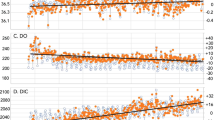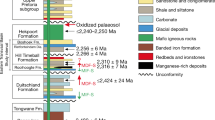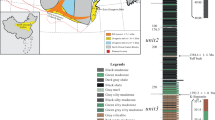Abstract
During the last glacial termination, the solubility of gases in the ocean decreased as ocean temperatures rose. However, marine sediments have not unanimously recorded ocean deoxygenation throughout this time. Some records show increasing oxygenation since the Last Glacial Maximum, particularly in the deep sea, while many document abrupt oxygenation changes, often associated with apparent changes in the formation rate of North Atlantic Deep Water. Here we present a global compilation of marine sediment proxy records that reveals remarkable coherency between regional oxygenation changes throughout deglaciation. The upper ocean generally became less oxygenated, but this general trend included pauses and even reversals, reflecting changes in nutrient supply, respiration rates and ventilation. The most pronounced deoxygenation episode in the upper ocean occurred midway through the deglaciation, associated with a reinvigoration of North Atlantic Deep Water formation. At this time, the upper Indo-Pacific Ocean was less oxygenated than today. Meanwhile, the bulk of the deep ocean became more oxygenated over the deglaciation, reflecting a transfer of respired carbon to the atmosphere. The observed divergence from a simple solubility control emphasizes the degree to which oxygen consumption patterns can be altered by changes in ocean circulation and marine ecosystems.
This is a preview of subscription content, access via your institution
Access options
Subscribe to this journal
Receive 12 print issues and online access
$259.00 per year
only $21.58 per issue
Buy this article
- Purchase on Springer Link
- Instant access to full article PDF
Prices may be subject to local taxes which are calculated during checkout





Similar content being viewed by others
References
Keeling, R. F. & Garcia, H. E. The change in oceanic O2 inventory associated with recent global warming. Proc. Natl Acad. Sci. 99, 7848–7853 (2002).
Gnanadesikan, A., Russell, J. L. & Zeng, F. How does ocean ventilation change under global warming? Ocean Sci. 3, 43–53 (2007).
Deutsch, C., Brix, H., Ito, T., Frenzel, H. & Thompson, L. Climate-forced variability of ocean hypoxia. Science 333, 336–339 (2011).
Emerson, S., Watanabe, Y. W., Ono, T. & Mecking, S. Temporal trends in apparent oxygen utilization in the upper pycnocline of the North Pacific: 1980–2000. J. Oceanogr. 60, 139–147 (2004).
Ito, T. & Deutsch, C. A conceptual model for the temporal spectrum of oceanic oxygen variability. Geophys. Res. Lett. 37, L03601 (2010).
Margo Project Members, Constraints on the magnitude and patterns of ocean cooling at the Last Glacial Maximum. Nature Geosci. 2, 1–6 (2009).
Muratli, J. M., Chase, Z., Mix, A. C. & McManus, J. Increased glacial-age ventilation of the Chilean margin by Antarctic Intermediate Water. Nature Geosci. 3, 23–26 (2010).
Galbraith, E. D., Kienast, M., Pedersen, T. F. & Calvert, S. E. Glacial–interglacial modulation of the marine nitrogen cycle by high-latitude O2 supply to the global thermocline. Paleoceanography 19, PA4007 (2004).
Altabet, M. A., Francois, R., Murray, D. W. & Prell, W. L. Climate-related variations in denitrification in the Arabian Sea from sediment 15N/14N ratios. Nature 373, 506–509 (1995).
Ganeshram, R. S., Pedersen, T. F., Calvert, S. E. & Murray, J. W. Large changes in oceanic nutrient inventories from glacial to interglacial periods. Nature 376, 755–758 (1995).
Ganeshram, R. S., Pedersen, T. F., Calvert, S. E. & François, R. Reduced nitrogen fixation in the glacial ocean inferred from changes in marine nitrogen and phosphorus inventories. Nature 415, 156–159 (2002).
Sigman, D. M. & Boyle, E. A. Glacial/interglacial variations in atmospheric carbon dioxide. Nature 407, 859–869 (2000).
Galbraith, E. D. et al. Carbon dioxide release from the North Pacific abyss during the last deglaciation. Nature 449, 890–894 (2007).
Jaccard, S. L. et al. Subarctic Pacific evidence for a glacial deepening of the oceanic respired carbon pool. Earth Planet. Sci. Lett. 277, 156–165 (2009).
Bradtmiller, L. I., Anderson, R. F., Sachs, J. P. & Fleisher, M. Q. A deeper respired carbon pool in the glacial equatorial Pacific Ocean. Earth Planet. Sci. Lett. 299, 417–425 (2010).
Altabet, M. A. et al. The nitrogen biogeochemistry of sinking particles from the margin of the Eastern North Pacific. Deep-Sea Res. I 46, 655–679 (1999).
Baas, J. H., Schönfeld, J. & Zahn, R. Mid-depth oxygen drawdown during Heinrich events: Evidence from benthic foraminiferal community structure, trace-fossil tiering, and benthic δ13C at the Portuguese Margin. Mar. Geol. 152, 25–55 (1998).
Crusius, J., Pedersen, T. F., Kienast, S. S., Keigwin, L. & Labeyrie, L. D. Influence of northwest Pacific productivity on North Pacific Intermediate Water oxygen concentrations during the Bølling–Ållerød interval (14.7–12.9 kyr). Geology 32, 633–636 (2004).
Cannariato, K. G. & Kennett, J. P. California margin oxygen-minimum zone during the past 60 k.y. Geology 27, 975–978 (1999).
Ito, T. & Follows, M. J. Preformed phosphate, soft tissue pump and atmospheric CO2 . J. Mar. Res. 63, 813–839 (2005).
Martin, P., Archer, D. & Lea, D. W. Role of deep sea temperature in the carbon cycle during the last glacial. Paleoceanography 20, PA2015 (2005).
Adkins, J. F., McIntyre, K. & Schrag, D. P. The salinity, temperature, and δ18O of the Glacial Deep Ocean. Science 298, 1769–1773 (2002).
Skinner, L. C., Fallon, S., Waelbroeck, C., Michel, E. & Barker, S. Ventilation of the Deep Southern Ocean and Deglacial CO2 Rise. Science 328, 1147–1152 (2010).
Matsumoto, K. Biology-mediated temperature control on atmospheric pCO2 and ocean biogeochemistry. Geophys. Res. Lett. 34, L20605 (2007).
Keigwin, L. D. & Lehman, S. J. Deep circulation change linked to HEINRICH event 1 and Younger Dryas in a middepth North Atlantic core. Paleoceanography 9, 185–194 (1994).
Ivanochko, T. S. et al. Variations in tropical convection as an amplifier of global climate change at the millenial scale. Earth Planet. Sci. Lett. 235, 302–314 (2005).
Schulz, H., von Rad, U. & Erlenkeuser, H. Correlation between Arabian Sea and Greenland climate oscillations of the past 110,000 years. Nature 393, 54–57 (1998).
Altabet, M. A., François, R., Murray, D. W. & Prell, W. L. Climate-related variations in denitrification in the Arabian Sea from sediment 15N/14N ratios. Nature 373, 506–509 (1995).
Schmittner, A., Galbraith, E. D., Hostetler, S. W., Pedersen, T. F. & Zhang, R. Large fluctuations of dissolved oxygen in the Indian and Pacific oceans during Dansgaard–Oeschger oscillations caused by variations of North Atlantic Deep Water subduction. Paleoceanography 22, PA3207 (2007).
Kienast, M. et al. Eastern Pacific cooling and Atlantic overturning circulation during the last deglaciation. Nature 443, 846–849 (2006).
Hayes, C. T., Anderson, R. F. & Fleisher, M. Q. Opal accumulation rates in the equatorial Pacific and mechanisms of deglaciation. Paleoceanography 26, PA1207 (2011).
Anderson, R. F. et al. Wind-driven upwelling in the Southern Ocean and the deglacial rise in atmospheric CO2 . Science 323, 1143–1448 (2009).
Brunelle, B. G. et al. Glacial/interglacial changes in nutrient supply and stratification in the western subarctic North Pacific since the penultimate glacial maximum. Quat. Sci. Rev. 29, 2579–2590 (2010).
Ortiz, J. D. et al. Enhanced marine productivity off western North America during warm climate intervals of the past 52 k.y. Geology 32, 521–524 (2004).
Robinson, R. S., Martinez, P., Pena, L. D. & Cacho, I. Nitrogen isotopic evidence for deglacial changes in nutrient supply in the eastern equatorial Pacific. Paleoceanography 24, PA4213 (2009).
Zheng, Y., van Geen, A., Anderson, R. F., Gardner, J. V. & Dean, W. E. Intensification of the northeast Pacific oxygen minimum zone during the Bölling–Alleröd warm period. Paleoceanography 15, 528–536 (2000).
Barker, S., Knorr, G., Vautravers, M. J., Diz, P. & Skinner, L. C. Extreme deepening of the Atlantic overturning circulation during deglaciation. Nature Geosci. 3, 567–571 (2010).
Gruber, N. & Galloway, J. N. An Earth-system perspective of the global nitrogen cycle. Nature 451, 293–296 (2008).
Ravishankara, A. R., Daniel, J. S. & Portmann, R. W. Nitrous oxide (N2O): The dominant ozone-depleting substance emitted in the 21st century. Science 326, 123–125 (2009).
Suthhof, A., Ittekkot, V. & Gaye-Haake, B. Millennial-scale oscillation of denitrification intensity in the Arabian Sea during the late Quaternary and its potential influence on atmospheric N2O and global climate. Glob. Biogeochem. Cycles 15, 637–649 (2001).
Thunell, R. C. & Kepple, A. B. Glacial-Holocene δ15 N record from the Gulf of Tehuantepec, Mexico: Implications for denitrification in the eastern equatorial Pacific and changes in atmospheric N2O. Glob. Biogeochem. Cycles 18, GB1001 (2004).
Schmittner, A. & Galbraith, E. D. Glacial greenhouse-gas fluctuations controlled by ocean circulation changes. Nature 456, 373–376 (2008).
Marinov, I., Follows, M. J., Gnanadesikan, A., Sarmiento, J. L. & Slater, R. D. How does ocean biology affect atmospheric pCO2? Theory and models. J. Geophys. Res. 113, C07032 (2008).
Jaccard, S. L. et al. Glacial/interglacial changes in subarctic North Pacific stratification. Science 308, 1003–1006 (2005).
Marchitto, T. M., Lynch-Stieglitz, J. & Hemming, S. R. Deep Pacific CaCO3 compensation and glacial–interglacial atmospheric CO2 . Earth Planet. Sci. Lett. 231, 317–336 (2005).
Huybers, P. & Langmuir, C. Feedback between deglaciation, volcanism, and atmospheric CO2 . Earth Planet. Sci. Lett. 286, 479–491 (2009).
Lüthi, D. et al. High-resolution carbon dioxide concentration record 650,000-800,000 year before present. Nature 453, 379–382 (2008).
Schilt, A. et al. Atmospheric nitrous oxide during the past 140,000 years. Earth Planet. Sci. Lett. 29, 182–192 (2010).
NGICP Project Members, High-resolution record of Northern Hemisphere climate extending into the last interglacial period. Nature 431, 147–151 (2004).
EPICA Project Members, Eight glacial cycles from an Antarctic ice core. Nature 429, 623–628 (2004).
Acknowledgements
E.D.G. thanks NSERC and CIFAR for financial support. D. Bianchi and N. Gruber commented on an early version of the manuscript.
Author information
Authors and Affiliations
Contributions
S.L.J. and E.D.G. jointly initiated the research project, and both contributed to the interpretation of the results and writing of the manuscript. S.L.J. compiled available data from the literature. E.D.G. performed the data analysis and created the figures.
Corresponding authors
Ethics declarations
Competing interests
The authors declare no competing financial interests.
Supplementary information
Supplementary Information
Supplementary Information (PDF 614 kb)
Supplementary Information
Supplementary Information (XLS 81 kb)
Rights and permissions
About this article
Cite this article
Jaccard, S., Galbraith, E. Large climate-driven changes of oceanic oxygen concentrations during the last deglaciation. Nature Geosci 5, 151–156 (2012). https://doi.org/10.1038/ngeo1352
Received:
Accepted:
Published:
Issue Date:
DOI: https://doi.org/10.1038/ngeo1352
This article is cited by
-
Indian Ocean glacial deoxygenation and respired carbon accumulation during mid-late Quaternary ice ages
Nature Communications (2023)
-
Southern Ocean glacial conditions and their influence on deglacial events
Nature Reviews Earth & Environment (2023)
-
Continental configuration controls ocean oxygenation during the Phanerozoic
Nature (2022)
-
The Peruvian oxygen minimum zone was similar in extent but weaker during the Last Glacial Maximum than Late Holocene
Communications Earth & Environment (2022)
-
Volcanic trigger of ocean deoxygenation during Cordilleran ice sheet retreat
Nature (2022)



